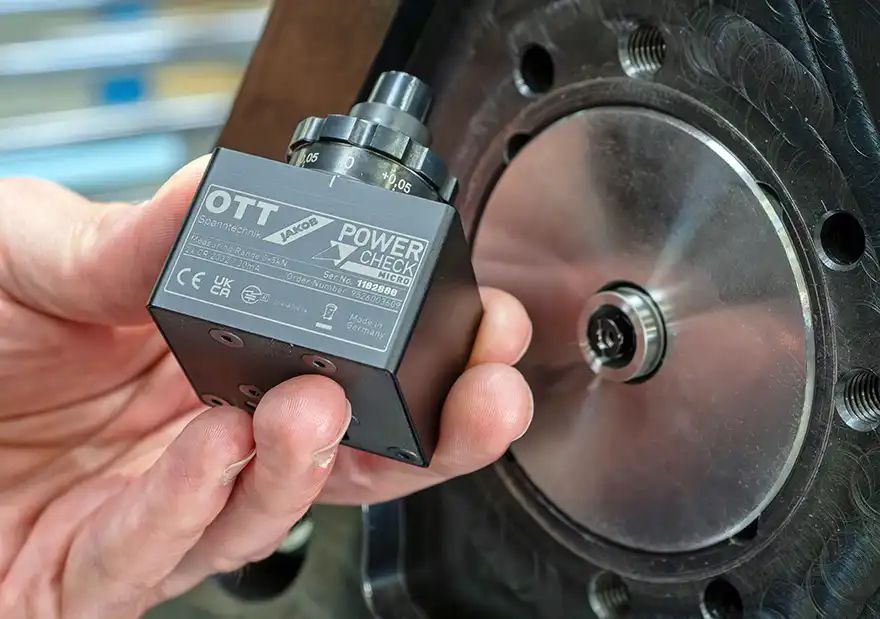 OTT-JAKOB Spanntechnik’s Power-Check Micro tool pull-in force measuring device for HSK E15, E16 and E20 interfaces, which is ideal for use in confined spacesOTT-JAKOB Spanntechnik
OTT-JAKOB Spanntechnik’s Power-Check Micro tool pull-in force measuring device for HSK E15, E16 and E20 interfaces, which is ideal for use in confined spacesOTT-JAKOB Spanntechnik, a German manufacturer of tool clamping systems for lathes, milling machines and grinders, has launched a new spindle clamping force measuring device, the Power-Check Micro. A key component for preventative maintenance, it has been introduced alongside the established Power-Check 2 and Power Check Magazine, which determine the pull-in force with which a tool holder is held in a large diameter spindle taper, whether it is HSK (up to 160), BT (30, 40 or 50), SK, CAT or another type.
In contrast, the Power-Check Micro is designed to perform an equivalent job for more compact HSK E15, E16 and E20 spindle interfaces, which are mainly found on small, precise machine tools intended for high-speed cutting. Such machining platforms are typically utilised in the dentistry and jewellery sectors, as well as for production of small parts for electronic and medical products, precision components in aerospace and automotive engineering, and small tools and dies.
These pull force measuring units are exclusively available in Britain and Ireland through sole sales agent
Gewefa UK. The company points out that the new device is pertinent to nearly all micro-manufacturing applications, where there is a growing emphasis on process reliability, condition monitoring, preventative maintenance and quality assurance.
The latest drawbar force monitoring system is of compact design, measuring just 48.8 x 43 x 41.5mm and weighing approximately 200g, making the unit well suited to use in constrained working areas. Mains-independent, it is powered by two replaceable lithium batteries capable of up to 1,000 hours of continuous operation.
Precision and reliabilityThe device is compatible with three interchangeable, screw-on adapters for the different HSK sizes and can be used with tool clamping systems from all manufacturers. In common with its larger counterparts, Power-Check Micro tests for how much axial force is exerted by a machine’s drawbar to pull and hold the tool holder securely into the spindle taper. It is an important parameter to check in production environments, where precision and reliability are paramount. Even minor deviations in clamping force over time can lead to accelerated tool wear, machine downtime, poor surface quality due to vibration, or, in extreme cases, tool failure.
Based on proven technology, Power-Check Micro offers high standards of precision, robustness of construction and ease-of-use, but in a compact arrangement tailored to the specific requirements of small-format machines. The measurement of forces up to 5.0kN is possible and the unit maintains consistent accuracy within ±0.1kN over the entire range. This performance is achieved within an operating temperature span of 10°C to 35°C and in relative humidity of up to 50%, ensuring reliable results in standard workshop conditions.
An innovative feature of the device is its adjustment ring with 0.05mm graduations, which enables the user to simulate different tool holder tolerances. In traditional systems that assess pull-in force, measurements are referenced to nominal sizes. However, real-world components often fall within a tolerance band, rather than precise values. With the Power-Check Micro, users can simulate shorter or longer tool interface dimensions by turning the ring within a ±0.2mm range. It allows deviations in tool geometry to be accommodated, ensuring that results reflect actual clamping performance rather than theoretical values.
Simple yet effectiveTo ensure safety and prevent damage, the device is designed for manual insertion and, unlike the Power-Check Magazine, not for exchange during automatic tool change cycles. Neither model should be presented to the spindle while it is rotating, which could result in ejection and injury. During a force inspection cycle, the user simply switches on the unit, places it into the tool interface by hand and initiates the drawbar clamping action via the machine control.
Active status is indicated by a flashing green LED, whereupon the Power-Check Micro transmits one data point per second to a connected receiver. After the measurement is complete, the user releases the clamping mechanism, removes the device and powers it off. This simple yet effective procedure facilitates routine force checking, without the need for complex setups or additional equipment.
The system’s 2.4GHz wireless transmission capabilities are supported by multiple OTT-JAKOB receiver options, including a USB radio stick for PC-based data logging, software-based analysis and export, as well as modules such as Radio RS 485-A/D and Radio IO-Link that support integration into the machine tool control and modern digital manufacturing environments.
The Power-Check Micro is available as a stand-alone unit or as part of a complete measurement kit, which includes a rugged storage case, a USB radio receiver, batteries, operating instructions, and PC software including a driver on a USB stick. To ensure long-term accuracy and peak performance, OTT-JAKOB recommends annual recalibration and regular visual inspection.